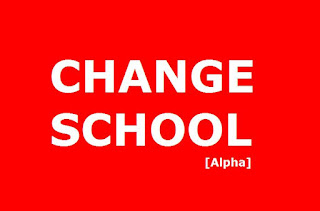
Yesterday, I had the unique opportunity to go indoor rock climbing with my daughter in a facility like the one in the picture. I have to admit that I was a bit hesitant to participate myself, since for those of you who do not know me personally, I was at one time close to 300 pounds in weight and never had much confidence in activities like this. I was an athlete in high school and college and since I have lost a significant amount of weight, so I decided to give it a go. I think this is what some of our students must feel like when we ask them to do things that are completely outside of their character. The fear of failure and what the perception will be of the others around completely controls their behavior because they do not feel safe enough to take risks.
 When I first strapped on the climbing gear I started getting a little nervous and I was in a facility with a lot of kids (Spring Break Week here!) and a few parents there watching their kids try to assault these walls of fabricated rock formations which are screwed into the wall. The wall or pyramid we are attempting to get students to climb is the revised version of Bloom's Taxonomy, pictured below. As teachers, when students start we try to provide more places where students can place their hands and feet to assist them getting up the wall. As their technique and skill level improves, we remove
When I first strapped on the climbing gear I started getting a little nervous and I was in a facility with a lot of kids (Spring Break Week here!) and a few parents there watching their kids try to assault these walls of fabricated rock formations which are screwed into the wall. The wall or pyramid we are attempting to get students to climb is the revised version of Bloom's Taxonomy, pictured below. As teachers, when students start we try to provide more places where students can place their hands and feet to assist them getting up the wall. As their technique and skill level improves, we remove  some of the supports that we initially provided. As for me on the rock wall... I missed on my first attempt up the wall, but I was successful in 7 subsequent attempts, including the course I missed on my first attempt. After I was successful the first time, it became easier and easier to transfer those skills and confidence to other climbing courses in the facility. Many of our students act the same way, a single success can be parlayed into a series of successes.
some of the supports that we initially provided. As for me on the rock wall... I missed on my first attempt up the wall, but I was successful in 7 subsequent attempts, including the course I missed on my first attempt. After I was successful the first time, it became easier and easier to transfer those skills and confidence to other climbing courses in the facility. Many of our students act the same way, a single success can be parlayed into a series of successes.Too much of the time, our goals are tied to high stakes testing, which has limited value, since once the test is over, students usually do not maintain mastery of the material because it is typically learned out of context. The material has no meaning, because it was not applied to a particular idea. HOTS (Higher Order Thinking Skills) help move students up the Bloom's pyramid. Project based learning, blogging, podcasting, video, etc. allow students to apply, analyze, synthesize and create their own mental maps and internalize the learning that has taken place.
Another aspect of high stakes testing is the fact that the tests are designed to measure a body of knowledge to be learned in a particular year and some students will be able to learn in that time frame, while others will not. Some of the work of Saphier and the Research for Better Teaching program, discussing teaching loops and support for learners can assist teachers in enhancing their own repertoire and in turn helping students achieve. What we are really after is creating a system where students can demonstrate mastery in a particular subject.
Will Richardson on his blog mentions some use of Web 2.0 tools and their value in allowing teachers to share, refine and connect to other teachers.
I know it would require some front end loading, but if districts were using wikis to house curriculum and encouraging teachers to work off of them as they move through the year, noting, tweaking, fine tuning, reflecting, etc., it would be one way that they could begin to make good use of a Web 2.0 tool and make it easier to connect to what other folks are doing. Not to mention the growing of some very important local network connections (which then, of course, could be expanded out.) And the other piece, of course, is that it’s a “safe” way to get started at least in terms of not having to deal with student participation issues.
Go back to the first "Change School" post. "Personally honest, but institutionally corrupt." What structures are in place that will help teachers move forward and improve their teaching? But that is for another post.
Are you ready to adjust the path along the pyramid with supports to help students initially move up the pyramid, but then remove the supports to provide students with an authentic learning experience?
1 comment:
The first goal of teaching is not climbing pyramids, but thinking. See the new book on amazon.com: "Teaching and Helping Students Think and Do Better".
Post a Comment